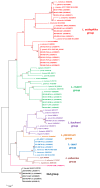Lactobacillus species isolated from vaginal secretions of healthy and bacterial vaginosis-intermediate Mexican women: a prospective study
- PMID: 23617246
- PMCID: PMC3655868
- DOI: 10.1186/1471-2334-13-189
Lactobacillus species isolated from vaginal secretions of healthy and bacterial vaginosis-intermediate Mexican women: a prospective study
Abstract
Background: Lactobacillus jensenii, L. iners, L. crispatus and L. gasseri are the most frequently occurring lactobacilli in the vagina. However, the native species vary widely according to the studied population. The present study was performed to genetically determine the identity of Lactobacillus strains present in the vaginal discharge of healthy and bacterial vaginosis (BV) intermediate Mexican women.
Methods: In a prospective study, 31 strains preliminarily identified as Lactobacillus species were isolated from 21 samples collected from 105 non-pregnant Mexican women. The samples were classified into groups according to the Nugent score criteria proposed for detection of BV: normal (N), intermediate (I) and bacterial vaginosis (BV). We examined the isolates using culture-based methods as well as molecular analysis of the V1-V3 regions of the 16S rRNA gene. Enterobacterial repetitive intergenic consensus (ERIC) sequence analysis was performed to reject clones.
Results: Clinical isolates (25/31) were classified into four groups based on sequencing and analysis of the 16S rRNA gene: L. acidophilus (14/25), L. reuteri (6/25), L. casei (4/25) and L. buchneri (1/25). The remaining six isolates were presumptively identified as Enterococcus species. Within the L. acidophilus group, L. gasseri was the most frequently isolated species, followed by L. jensenii and L. crispatus. L. fermentum, L. rhamnosus and L. brevis were also isolated, and were placed in the L. reuteri, L. casei and L. buchneri groups, respectively. ERIC profile analysis showed intraspecific variability amongst the L. gasseri and L. fermentum species.
Conclusions: These findings agree with previous studies showing that L. crispatus, L. gasseri and L. jensenii are consistently present in the healthy vaginal ecosystem. Additional species or phylotypes were detected in the vaginal microbiota of the non-pregnant Mexican (Hispanic-mestizo) population, and thus, these results further our understanding of vaginal lactobacilli colonisation and richness in this particular population.
Figures


Similar articles
-
Vaginal microbiota of asymptomatic bacterial vaginosis and vulvovaginal candidiasis: Are they different from normal microbiota?Microb Pathog. 2019 Sep;134:103599. doi: 10.1016/j.micpath.2019.103599. Epub 2019 Jun 15. Microb Pathog. 2019. PMID: 31212037
-
Vaginal lactobacilli profile in pregnant women with normal & abnormal vaginal flora.Indian J Med Res. 2017 Oct;146(4):534-540. doi: 10.4103/ijmr.IJMR_774_16. Indian J Med Res. 2017. PMID: 29434069 Free PMC article.
-
Association between Lactobacillus species and bacterial vaginosis-related bacteria, and bacterial vaginosis scores in pregnant Japanese women.BMC Infect Dis. 2007 Nov 7;7:128. doi: 10.1186/1471-2334-7-128. BMC Infect Dis. 2007. PMID: 17986357 Free PMC article.
-
The association between vaginal microbiota and female infertility: a systematic review and meta-analysis.Arch Gynecol Obstet. 2020 Sep;302(3):569-578. doi: 10.1007/s00404-020-05675-3. Epub 2020 Jul 8. Arch Gynecol Obstet. 2020. PMID: 32638096
-
[Characteristics and physiologic role of female lower genital microbiome].Orv Hetil. 2023 Jun 18;164(24):923-930. doi: 10.1556/650.2023.32791. Print 2023 Jun 18. Orv Hetil. 2023. PMID: 37330978 Review. Hungarian.
Cited by
-
The vaginal microbiota: what have we learned after a decade of molecular characterization?PLoS One. 2014 Aug 22;9(8):e105998. doi: 10.1371/journal.pone.0105998. eCollection 2014. PLoS One. 2014. PMID: 25148517 Free PMC article.
-
Simultaneous application of oral and intravaginal probiotics for Helicobacter pylori and its antibiotic-therapy-induced vaginal dysbacteriosis.NPJ Biofilms Microbiomes. 2024 Jun 20;10(1):49. doi: 10.1038/s41522-024-00521-9. NPJ Biofilms Microbiomes. 2024. PMID: 38902244 Free PMC article. Review.
-
Vaginal Lactobacilli Induce Differentiation of Monocytic Precursors Toward Langerhans-like Cells: in Vitro Evidence.Front Immunol. 2018 Oct 23;9:2437. doi: 10.3389/fimmu.2018.02437. eCollection 2018. Front Immunol. 2018. PMID: 30410487 Free PMC article.
-
Evaluation of inhibitory and probiotic properties of lactic acid bacteria isolated from vaginal microflora.Folia Microbiol (Praha). 2022 Jun;67(3):427-445. doi: 10.1007/s12223-021-00942-5. Epub 2022 Jan 27. Folia Microbiol (Praha). 2022. PMID: 35083726
-
Benzoyl peroxide formulated polycarbophil/carbopol 934P hydrogel with selective antimicrobial activity, potentially beneficial for treatment and prevention of bacterial vaginosis.Infect Dis Obstet Gynecol. 2013;2013:909354. doi: 10.1155/2013/909354. Epub 2013 Dec 7. Infect Dis Obstet Gynecol. 2013. PMID: 24382940 Free PMC article.
References
-
- Angeles-López M, García-Cano E, Aquino SC. Hydrogen peroxide production and resistance to nonoxinol-9 in Lactobacillus spp. isolated from the vagina of reproductive age women. Rev Latinoam Microbiol. 2001;43:171–176. - PubMed
Publication types
MeSH terms
Substances
LinkOut - more resources
Full Text Sources
Other Literature Sources
Molecular Biology Databases

